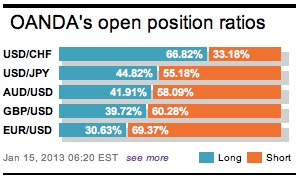The European markets have thrown a slight curveball this morning; opening up in a downbeat mood after helicopter Ben’s speech late yesterday afternoon has failed to inspire traders. While insisting that the US economy was still fragile, suggests that the Fed and Bernanke would stick for now with their ‘unconventional programs’ to improve production. That would certainly indicate no early exit from their current QE program. Not making matters any easier for traders is the policy managed ‘one-directional’ Yen trade reversing its flow, most likely temporarily, on concerns about excessive weakening of the Japanese currency. Since the beginning of Q4, Yen, trader’s primary risk aversion currency of choice, has depreciated -15%. Giving some of that back is healthy for any market!

Bernanke was unable to avoid expressing his concerns about the US debt ceiling at his free for all question period yesterday. He insisted that Congress take the necessary actions to raise the debt ceiling to avoid the possibility of non-payment of bills. In reality, unless the ceiling is shifted, the world’s largest economy may cease to function by mid-February. As someone suggested, this could be described as the next stage of the “bungee jump” following the fiscal resolution at this years turn. Have we been witnessing the market’s upturn of late? Perhaps this recent bounce in most assets classes is about to be followed by the downturn?
It’s a quiet week in Europe on the data front with only CPI remaining of note out tomorrow. The single currency has gained significant support from President Draghi’s reluctance to signal pre-emptive easing measures at last week’s ECB meet. Despite yesterday’s Euro data reinforcing the extent of the euro-zones growth deficit, the currency still has ‘legs.’ Over time, because of growth issues, one would expect that this market would want to start pricing in some easing expectations. Until then, most investors are taking directional advice from the Fixed Income market.
Spain returns to the bond debt market this Thursday, offering 15, 18 and 41-year paper. Again, expect markets to closely follow the outcome of theses offerings for any signs of stress. If the periphery debt auctions falter, the cocktail mix of weak growth and financial stress will lead to the EUR’s current strength being undermined. This morning there was a decent cover for the Spanish bill auction (EUR5.75b of bills sold versus the prior amount of EUR3.89b), which supports the EUR bulls momentum forecast for the single unit. With the bid-to-cover holding at decent levels, appetite for periphery debt suggests that the EUR is supported on pullbacks for the moment.
Following yields is making the currency roadmap a tad easier to read at the moment. For now the market seems to be reassessing the risk associated with the sovereign Euro-zone debt crisis. As periphery bond-yields pull back, they are relieving pressure on some of the risk haven trading strategies, no more so than the EUR/CHF. Since late last Friday, northbound momentum has propelled the currency pair to trade through the 1.23 psychological barrier, triggering some fresh option barriers. Dealers are now focusing on 1.24 (this morning) and 1.25 as the next legitimate option target barrier, despite the EUR outright trying to wither against the ‘big dollar.’ Once a barrier is penetrated it forces a percentage of investors to sell their long CHF positions, supporting the EUR.

UK inflation held at +2.7% this morning for the third consecutive month in December, in line with expectations, as a rise in gas and electricity (+3.9%, y/y) offset falling fuel costs (-0.2%). Stubborn inflation, above the BoE’s +2% is a strong argument against more QE to support growth at the bank’s monthly policy meeting last week. High inflation is also pressurizing consumer spending, making it more difficult to fend off recession. Similar scenes are occurring in the Euro-zone. Germany, considered the economic backbone of Europe, growth slowed markedly last year according to the federal stats office this morning. Price adjusted GDP expanded +0.7% after increasing +3% the previous year. A breakdown for Q4 is yet to be published, however, the market is currently bulling the EUR on the headline, but how far?
Now we get to see how much metal the ‘single currency’ has. Buying dips remains the markets favored action, looking for a move towards the 50% retrace of the 2011-12 decline, somewhere just shy of 1.35. Intraday pricing is working lower after some negative German headline. For the EUR of late, any fundamental negativity is having a limited impact. Is this another of those scenarios?

Other Links:
EUR/USD – Euro Trading at Multi-Month Highs
This article is for general information purposes only. It is not investment advice or a solution to buy or sell securities. Opinions are the authors; not necessarily that of OANDA Corporation or any of its affiliates, subsidiaries, officers or directors. Leveraged trading is high risk and not suitable for all. You could lose all of your deposited funds.


